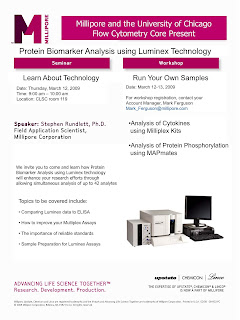
The Flow Lab's legacy FACSAria is finally getting its fluidics upgrade today. The process takes about 3 days, so I'll give you some updates via photos. Day 1 was basically demo day, and the pic displayed here is the Fluidics area inside which has been totally ripped out. It looks a bit messy now, but the new system is much more stream-lined than the old. For those of you not familiar with the benefits of the fluidics upgrade, I'll give you a quick run-down and a bit of history. 1st the history. Sorters, for years have used a very simple process for driving fluidics; fill a tank with PBS, pressurize the tank at constant pressure, which causes the fluid to move through the system at a constant velocity, thereby giving a stable droplet break-off pattern. Enter BD and their quest to put a sorter on every researcher's desk. BD developed a fluidics system which was marketed as a "bench-top" sorter which could be run by anyone. Everything is automated, cleaning, sterilizing, running, monitoring, etc... In attempting to make this "easy-to-use" sorter, they created a service nightmare. There were so many valves and switches and pumps put in to do the simple job of moving PBS from a tank to a flow cell that at any given point, one of them was not working properly. Additionally, with all the valves and switches and automation came many small pieces of tubing and hangouts for bugs and bacteria. This created a situation where we had to jump through hoops trying to keep the sorter clean. Other sorters, like the MoFlo still had the classic fluidics system and, at least in our hands, had almost zero fluidics problems over about a 10 year period, and very few contamination issues with little effort. After a few years of complaints and retooling, BD releases the FACSAria II, and guess what? They got rid of a ton of valves, switches, hideouts, and once again went back to a simplified, robust fluidics system. It still has a few bells and whistles, but certainly not as grotesquely over-engineered as the Aria I. Will it withstand the onslaught of abuse only a core facility like ours can dole out? Only time will tell. Regardless, you'll hear about it here, so stay tuned.



